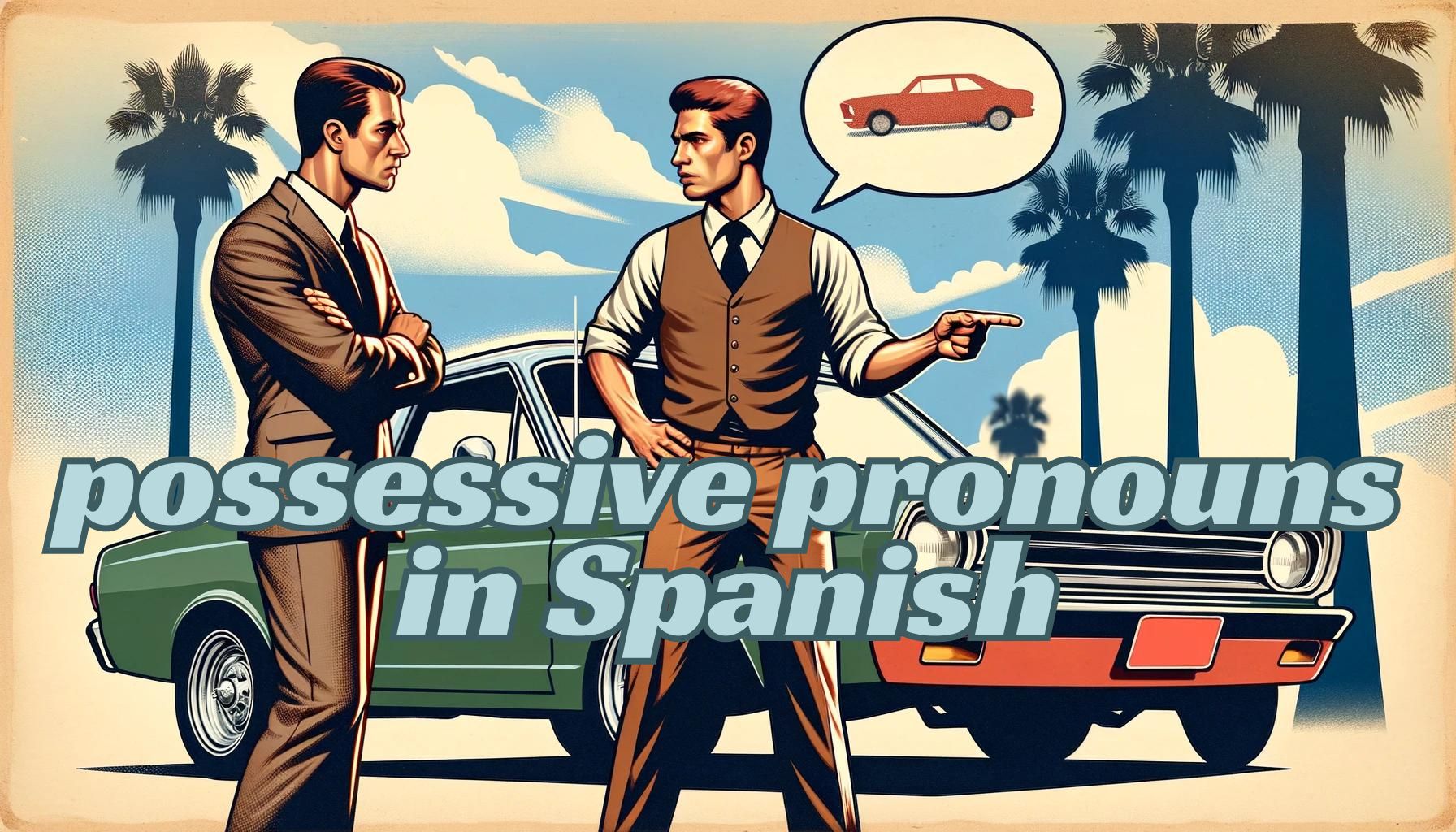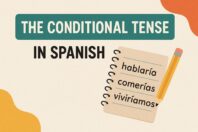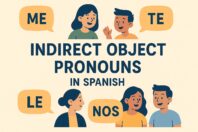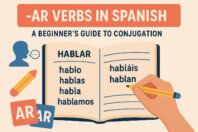Spanish Possessive Pronouns: A Complete Guide

Get our free email course, Shortcut to Conversational.
Have conversations faster, understand people when they speak fast, and other tested tips to learn faster.
More infoYou’re surely familiar with your English possessive pronouns: mine, yours, his, hers, ours, theirs. But do you know the equivalent Spanish possessive pronouns?
We’ve already introduced the other ways of expressing possession in some of our other posts:
- Short-form possessive adjectives: mi casa, tu casa – my house, your house
- Long-form possessive adjectives: la casa mía, la casa tuya – my house, your house
- The preposition De for possession: la casa de Pedro – Pedro’s house
- The relative pronoun cuyo: un escritor cuyas obras son famosas – a writer whose books are famous
In today’s post we offer a complete guide to the possessive pronouns in Spanish:
- Tu coche es demasiado pequeño. Usemos el mío. – Your car is too small. Let’s use mine.
We’ll start off by introducing all the Spanish possessive pronouns, which each come in four forms to match the gender and the number of the possessions they refer to. Then we’ll get into how to use possessive pronouns in Spanish, demonstrating their use with lots of examples. We’ll pay special attention to suyo, since we use this same possessive pronoun for numerous owners.
Once we’ve seen all of the possessive pronouns Spanish normally uses, we’ll see the particular case of their neuter form. We’ll also cover a handful of common Spanish expressions that contain possessive pronouns, explaining their particularities with respect to gender and number as well.
So let’s get started and dive into the world of possessive pronouns in Spanish!
What are the possessive pronouns in Spanish?
Before we present all the Spanish possessive pronouns, let’s just review the English ones for comparison. We’ll use the same format for the Spanish possessive pronouns chart below.
| Owner | English subject pronoun | English possessive pronoun |
| First-person singular owner | I | mine |
| Second-person singular owner | you | yours |
| Third-person singular owner | he, she, it | his, hers, its |
| First-person plural owner | we | ours |
| Second-person plural owner | you | yours |
| Third-person plural owner | they | theirs |
Did you notice that, in English, you have three different possessive pronouns that can refer back to third-person singular owners? His, hers, and its reflect the gender of the owner, referring respectively to subject pronouns of he, she, and it.
In Spanish, each grammatical person has its own possessive pronoun, regardless of which subject pronoun it refers to. This can indeed get confusing in the third person, as we’ll see further along when we dissect el suyo in more detail. Remember that the grammatical person of usted and ustedes is considered to be third person too!
For now, let’s just see our Spanish possessive pronouns chart. The pronoun for each grammatical person takes four different forms, depending on the gender and number of the possession.
| Owner | Masculine singular possession | Feminine singular possession | Masculine plural possessions | Feminine plural possessions |
| First-person singular owner | el mío | la mía | los míos | las mías |
| Second-person singular owner | el tuyo | la tuya | los tuyos | las tuyas |
| Third-person singular owner | el suyo | la suya | los suyos | las suyas |
| First-person plural owner | el nuestro | la nuestra | los nuestros | las nuestras |
| Second-person plural owner | el vuestro | la vuestra | los vuestros | las vuestras |
| Third-person plural owner | el suyo | la suya | los suyos | las suyas |
Did you notice that all possessive pronouns in Spanish are made up of two words? We always need to include the definite article: el, la, los, las. The second word of the possessive pronoun is identical to the long-form possessive adjective. Both of these elements need to match the possession in gender and number.
To sum up the two tables we’ve just looked at, here’s our list of possessive pronouns in Spanish, with their translations in English. Remember that *usted and *ustedes act as third-person pronouns, so the various forms of el suyo can also be translated as yours in English.
| Owner | Spanish possessive pronoun | English translations |
| First-person singular owner | [article] mío/a(s) | mine |
| Second-person singular owner | [article] tuyo/a(s) | yours |
| Third-person singular owner | [article] suyo/a(s) | his, hers, its, yours* |
| First-person plural owner | [article] nuestro/a(s) | ours |
| Second-person plural owner | [article] vuestro/a(s) | yours |
| Third-person plural owner | [article] suyo/a(s) | theirs, yours* |
Now that we’ve seen all of the Spanish possessive pronouns, let’s use them in a few examples. We’ll go into more detail in the next section.
- Su carro es rojo y el mío es verde. – His car is red and mine is green.
- Las cartas de mi abuela llegaron tarde, las mías temprano. – My grandma’s letters arrived late, mine early.
- Mi hermana es médica, ¿y la tuya? – My sister is a doctor, ¿what about yours?
- Vuestras hijas son ángeles. Las nuestras nunca se portaron tan bien. – Your daughters are angels. Ours never behave so well.
- ¿Estas son nuestras cervezas o las suyas? – Are these our beers or theirs?
- Esta mesa es la nuestra, aquella es la suya, señores. – This table is ours, that one is yours, gentlemen.
Possessive pronouns vs long-form possessive adjectives
If you’re familiar with the long-form possessive adjectives, you may be wondering how to tell them apart from these possessive pronouns. Just remember that pronouns always replace a noun entirely, whereas adjectives generally appear alongside the noun. We can always recognize the pronouns since they appear as two words together.
The possessive pronoun from the first example above is “el mío,” for example, which would be “el carro mío” as a possessive adjective since we still include the noun, “carro.” If the noun is omitted but implied, there is no article, so it’s still a possessive adjective, as in “Su carro es rojo y [el carro] mío es verde.”
How to use possessive pronouns in Spanish
As we’ve seen so far, Spanish possessive pronouns reflect the grammatical person of their owner, just like in English. We also saw that each of these possessive pronouns has four forms, which need to agree with the gender and number of the possession. For each of the potential subject pronouns in Spanish, we can sum up the four forms of their grammatical person’s possessive pronouns in the following chart.
| Owner | Spanish possessive pronoun |
| yo | [article] mío/a(s) |
| tú | [article] tuyo/a(s) |
| él, ella, usted | [article] suyo/a(s) |
| nosotros, nosotras | [article] nuestro/a(s) |
| vosotros, vosotras | [article] vuestro/a(s) |
| ellos, ellas, ustedes | [article] suyo/a(s) |
Now let’s see some examples where we use the Spanish possessive pronouns that reflect first- and second-person owners. To demonstrate the different forms in the following examples, we point out the gender and number of the possession that the pronoun refers to.
- ¿Este es tu bolígrafo o es el mío? – Is this your pen or is it mine? (el bolígrafo: masculine singular)
- Su opinión es importante y la mía también. – Your opinion is important and so is mine. (la opinión: feminine singular)
- El bolso verde es el tuyo y el blanco es el mío. – The green bag is yours and the white one is mine. (el bolso: masculine singular)
- Nuestros pantalones son más caros que los tuyos. – Our pants are more expensive than yours. (los pantalones: masculine plural)
- Estas son mis tarjetas, las tuyas están en el cajón. – These are my cards, yours are in the drawer. (las tarjetas: feminine plural)
- Su hijo es inteligente, el nuestro también. – Their son is clever, ours too. (el hijo: masculine singular)
- Sus notas son mejores que las nuestras. – Your grades are better than ours. (las notas: feminine plural)
- Nuestra banda toca primero, luego la vuestra. – Our band plays first, then yours. (la banda: feminine singular)
- Compramos nuestras entradas en línea. ¿Dónde compró las vuestras? – We bought our entry tickets online. Where did you buy yours? (las entradas: feminine plural)
How to master Suyo, suya, suyos, suyas possessive pronouns Spanish
Hopefully you’re getting the hang of which Spanish possessive pronoun to use, depending on both the owner and the possession. But what about the various forms of el suyo, which we use for all singular and plural third-person subject pronouns?
Depending on who the owner is, the English translations for suyo, suyos, suya and suyas can be his, hers, its, yours (singular formal), theirs, and yours (plural).
You might be wondering how Spanish speakers can tell one from another. Well, context is the key. You’ll need to keep track of who you’re talking about within the conversation!
Sometimes the context still isn’t clear though. Let’s see this in an example where we can’t quite tell who each instance of el suyo is referring to:
- Mi esposa y yo iremos a una fiesta de cumpleaños combinada el sábado en la casa de Carla y Santiago. El suyo es el viernes y el suyo es el domingo. – My wife and I are going to a combined birthday party on Saturday at Carla and Santiago’s house. His/hers/theirs is on Friday and his/hers/theirs is on Sunday.
With sentences like this, even native speakers need clarification sometimes. In these cases, we have a specific structure for asking who the possessive pronoun is referring to. We just repeat the pronoun’s definite article and then use the possessive form of de to link it with the potential owners. We can use the owners’ names or their subject pronouns. The question looks like this:
- ¿Es [definite article] de [potential owner]?
So for our example where we’re not sure whose birthday is when, we can ask for clarification:
- ¿El viernes es el de tu esposa? / Sí. El de ella es el viernes y el de ellos el domingo. Carla y Santiago son gemelos. ¡El domingo es el cumpleaños de ambos! – Friday is your wife’s [birthday]? / Yes. Hers is Friday and theirs is Sunday. Carla and Santiago are twins. Sunday is the birthday of both of them!
Did you catch the other option for disambiguating third-person owners? We just use this same construction when we make the statement, instead of relying on the ambiguous forms of el suyo.
We sum this up in the following chart, where we show the options for masculine singular possessions. Remember that all nouns are either masculine or feminine, so there’s no separate word for *it in Spanish.
| Owner | Spanish possessive pronoun | Clearer alternative | English translation |
| él | el suyo | el de él | his, its* |
| ella | el suyo | el de ella | hers, its* |
| usted | el suyo | el de usted | yours (formal) |
| ellos | el suyo | el de ellos | theirs (masculine) |
| ellas | el suyo | el de ellas | theirs (feminine) |
| ustedes | el suyo | el de ustedes | yours (plural) |
Now let’s see a few examples where we choose between these different forms in order to clarify who the owner is.
- Nuestros hijos comparten una habitación y nuestra hija tiene su propia habitación. La de ellos es grande, pero la de ella recibe más luz solar. – Our sons share a room, and our daughter has her own room. Theirs is big, but hers gets more sunlight.
- Buenas tardes señor. Las habitaciones de hotel para su grupo están casi todas listas. Las de sus clientes ya están listas y la suya lo estará pronto. – Good afternoon, sir. The hotel rooms for your group are all almost ready. Those of your clients are already ready, and yours will be soon.
- Mañana son las competiciones masculinas y femeninas. La de ellos es por la mañana y la de ellas por la tarde. – The men’s and women’s competitions are tomorrow. Theirs [men’s] is in the morning and theirs [women’s] is in the afternoon.
The neutral possessive pronoun in Spanish
So far we’ve seen that the Spanish possessive pronouns all need to begin with a definite article and then have a matching form to reflect the gender and number of the possession. This formula is true for any tangible possessions, but we have an additional form for referring to intangible concepts: the neutral Spanish possessive pronoun.
This form can only be used when we refer to some general idea or concept. Instead of using one of the gender-specific definite articles, we use the neutral definite article Lo. Then we just use the masculine form of the possessive pronoun that corresponds to our subject.
- Lo tuyo fue increíble. – What you did was unbelievable.
- Tenemos que luchar por lo nuestro. – We have to fight for what is ours.
We can use this neuter form in a colloquial way to refer to someone’s passion, interest, or expertise in a particular area. It emphasizes that the person being referred to has a strong inclination or talent for doing something such as music, a sport, or any ability.
- Lo mío es el fútbol. – Soccer is my thing.
- Lo nuestro es el debate. – Debating is our thing.
Common expressions that have Spanish possessive pronouns
Before we wrap up today’s post, let’s see a few idiomatic expressions in Spanish that contain possessive pronouns.
We’ll present each of these expressions using the third-person possessive pronoun, but we’ll show through our examples that they can still be applied to other subjects. What’s important to keep in mind, however, is that the pronoun’s form still needs to respect the same gender and number within the expression.
Ir a lo suyo
To go one’s own way
Ir a lo suyo means that someone is doing their own thing, focusing on their own interests or concerns, and not getting caught up in or being influenced by what others are doing or saying. The possessive pronoun always needs to keep the neutral form.
- No se distraigan, chicas. Vayan a lo suyo. – Stay focus, girls. Go your own way.
- Dejemos de chismosear y vayamos a lo nuestro. – Let’s quit the gossip and let’s go our own way.
Hacer de las suyas
To be up to one’s tricks
This phrase may also be translated as to misbehave or to cause trouble. When someone hace de las suyas, it means that they are engaging in mischievous, unpredictable, or disruptive behavior. The possessive pronoun here always needs to keep the feminine plural form.
- Juan hizo de las suyas en la escuela hoy. – Juan misbehaved at school today.
- Otra vez haciendo de las tuyas, Tomás. ¡Compórtate por favor! – Tomás, you’re causing trouble again. Behave yourself, please!
Salirse con la suya
To get away with it
When someone se sale con la suya, it means that they manage to achieve what they want, even if others may have tried to prevent or oppose it. It implies a sense of satisfaction or triumph in successfully navigating a situation to their advantage.
- A pesar de los problemas que tuvo, Sebastián se salió con la suya y pudo viajar a China. – In spite of the problems he had, Sebastián got away with it and could travel to China.
- Ganamos el concurso. Pudimos salirnos con la nuestra. – We won the contest. We were able to get away with it.
The possessive pronoun here always needs to remain in the feminine singular form. Also note that the verb salir in this case requires a reflexive pronoun.
Conclusion: Spanish possessive pronouns
We’ve reached the end of today’s lesson, having covered everything you need to know about how to use possessive pronouns in Spanish.
We started off with the basics, showing full charts of both English and Spanish possessive pronouns. We saw how the Spanish versions are all formed of two words, with the first being a definite article and the second reflecting the grammatical person of the owner.
Like English, each grammatical person has its own corresponding possessive pronoun. With Spanish possessive pronouns, however, each one has four distinct forms to reflect the gender and number of the possession.
We spent a bit of time discussing the third-person possessive pronouns, since we use the same ones for several different potential owners. Besides just relying on context to keep the owners clear, we looked at alternative structures to express ownership with less ambiguity.
We rounded out our lesson with an introduction to the neutral possessive pronoun in Spanish, which always begins with lo and then uses the masculine form. Finally, we finished up with a few common expressions that include possessive pronouns in Spanish.
As always, we demonstrated our lesson with clear tables and with plenty of examples. If you’ve read this far you should have a solid understanding of how to use possessive pronouns in Spanish! To see how well you’ve mastered them, we’ll end today’s post with a set of exercises.
Exercises
Complete the sentences with the correct Spanish possessive pronouns to match the owner we note in parentheses.
1. Esa muñeca es tuya, aquella es _____ (nosotros).
2. El cine está lejos de mi casa, pero está cerca de _____ (tú).
3. ¿El teléfono que está sobre el escritorio es _____ (usted)?
4. Señor director, _____ (usted) es una buena propuesta.
5. Mi ropa está en el armario. _____ (ustedes) está en la lavadora.
6. Nosotros recordamos traer nuestros pasaportes. Vosotros no olviden traer _____ (vosotros).
7. Mi profesora de español es muy buena, pero _____ (él) es mejor.
Answers
1. Esa muñeca es tuya, aquella es la nuestra. – That doll is yours, that one over there is ours.
2. El cine está lejos de mi casa, pero está cerca de la tuya. – The cinema is far away from my house but it’s near yours.
3. ¿El teléfono que está sobre el escritorio es el suyo? – Is the phone on the desk yours?
4. Señor director, la suya es una buena propuesta. – Mr director, yours is a good proposal.
5. Mi ropa está en el armario. La suya está en la lavadora. – My clothing is in the closet, yours is in the washing machine.
6. Nosotros recordamos traer nuestros pasaportes. Vosotros no olviden traer los vuestros.
7. Mi profesora de español es muy buena, pero la suya es mejor. – My Spanish teacher is great but his is better.



